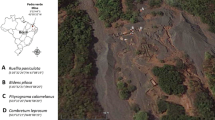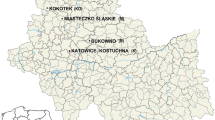Abstract
Soluble metals are of nutritional and ecotoxicological interest as they are the most readily available form to the biota. Metal solubility in soils is mostly controlled by pH and the organic matter content. The rhizosphere is generally considered as an environment enriched in organic matter and often more acidic (depending on nutritional status of the plant) than the bulk soil. Yet, there is a lack of consensus on the distribution of metals at the soil-root interface. Consequently, the specific objectives of this paper are to compare the chemical properties and the water extractable metal concentrations of the rhizosphere and the bulk soil of forest soil (1) along a gradient in soil contamination and (2) under different tree species. Two study areas were used: (1) Rouyn-Noranda (Canada) where samples were collected along a gradient in metal contamination at a distance of 0.5, 2 and 8 km downwind from a copper smelter; (2) Saint-Hippolyte (Canada) where the effect of three tree species (Abies balsamea, Acer saccharum and Betula papyrifera) was studied. In the field, the rhizosphere was operationally defined as the soil adhering to the roots after agitation, soil falling from the roots and the rest of the soil composing the bulk soil. Once in laboratory, a second agitation was performed to separate the rhizosphere into an inner and an outer component. Water extractable metal concentrations (Al, Ca, Cd, Co, Cr, Cu, Fe, Li, Mg, Mn, Ni, Pb and Zn) were quantified either with an ICP-AES or a GFAAS. Measurements of pH, electrical conductivity (EC), water-extractable organic carbon (WEOC) and solid phase organic carbon (SPOC) were performed. Results systematically indicate that EC, WEOC and SPOC follow the sequence inner rhizosphere > outer rhizosphere > bulk soil. The pH is always lower in the inner rhizosphere than in the bulk soil, while the outer rhizosphere frequently shows an inconstant behaviour. The results also show a clear gradient following inner rhizosphere > outer rhizosphere > bulk soil for water extractable Al, Ca, Cd, Cu, Fe, Mg, Mn, Ni, Pb and Zn. Li, Co and Cr levels were below method detection limit in all cases. WEOC seems to be the main variable related to the water-extractable metals concentrations. The gradient in metal contamination at Rouyn-Noranda was not as expected in the water extracts with the site at 2 km frequently presenting higher metal concentrations than the sites at 0.5 and 8 km. Moreover, a tree species effect did not clearly immerge for any of the chemical properties studied. However, the water extractable Ca concentrations were higher in the soil under Acer saccharum. The effects of the metal gradient and of the tree species may be more pronounced if stronger extractants are used. The addition of an outer rhizosphere component is useful as its behaviour is not consistently intermediate between the inner rhizosphere and bulk soil.
Similar content being viewed by others
References
Bélanger N, Côté B, Courchesne F, Fyles J W, Warjvinge P aand Hendershot W H 2002 Simulation of soil chemistry and nutrient availability in a forested ecosystem of southern Quebec. Part I. Reconstruction of time files of nutrient cycling using the MAKEDEP model. Environ. Mod. Software 17, 427–445.
Carter M R 1993 Soil Sampling and Methods of Analysis. Lewis Publishers, Boca Raton, USA. 823 pp.
Centre Saint-Laurent 2001 Détermination de la limite de detection d'une méthode d'analyse. Centre Saint-Laurent, Environment Canada, Montréal, Canada. 10 pp.
Courchesne F and Gobran G R 1997 Mineralogical variation of bulk and rhizosphere soils from a Norway spruce stand. Soil Sci. Soc. Am. J. 61, 1245–1249.
Courchesne F, Séguin V and Dufresne A 2001b Solid phase frac-tionation of metals in the rhizosphere of forested soils. In Trace Elements in the Rhizosphere. Eds. G R Gobran, W W Wenzel and E Lombi. pp 189–206. CRC Press, Boca Raton.
Couture P 1997 Vers un contrôle à 100% des émanations de SO2. Vecteur Environ. 30, 18–20.
Dumontet S, Dinel H and P E N Lévesque 1992 The distribution of pollutant heavy metals and their effect on soil respiration and acid phosphatase activity in mineral soils of the Rouyn-Noranda region, Québec. Sci. Total Envrion. 121, 231–245.
Dumontet S, Lévesque M and Mathur S P 1990 Limited downward migration of pollutant metals (Cu, Zn, Ni and Pb) in acidic virgin peat soils near a smelter. Water Air Soil Poll. 49, 329–342.
Fergusson J E 1990 The Heavy Metals: Chemistry, Environmental Impacts, and Health Effects. Oxford, New York, USA. 614 pp.
Finzi A C, Canham C D and van Breemen N 1998 Canopy tree –soil interactions within temperate forests: Species effects on pH and cations. Ecol. Appl. 8, 447–454.
Gahoonia T S 1993 Influence of root-induced pH on the solubility of soil aluminium in the rhizosphere. Plant Soil 149, 289–291.
Gobran G R and Clegg S 1996 A conceptual model for nutrient availability in the mineral soil-root system. Can. J. Soil Sc. 76, 125–131.
Gobran G R, Clegg S and Courchesne F 1998 Rhizospheric pro-cesses influencing the biogeochemistry of forest ecosystems. Biogeochem. 42, 107–120.
Göttlein A, Heim A and Matzner E 1999 Mobilization of aluminium in the rhizosphere soil solution of growing tree roots in an acidic soil. Plant Soil 121, 41–49.
Grayston S J, Vaughan D and Jones D 1996 Rhizosphere carbon flow in trees, in comparaison with annual plants: The importance of root exudation and its impact on microbial activity and nutrient availability. Appl. Soil Ecol. 5, 29–56.
Grinsted M J, Hedley M J, White R E and Nye P H 1982 Plant-induced changes in the rhizosphere of rape (Brassica napus var. emerald) seedlings. I. pH change and increase in P concentration in the soil solution. New Phytol. 91, 19–29.
Hedley M J, Nye P H and White R E 1982 Plant-induced changes in the rhizosphere of rape (Brassica napus var. emerald) seedlings. New Phytol. 91, 31–44.
Hinsinger P 1998 How do plant roots acquire mineral nutrients? Chemical processe involved in the rhizosphere. Adv. Agron. 24, 225–265.
Hinsinger P and Gilkes R J 1997 Dissolution of phosphate rock in the rhizosphere of five plant species grown un an acid, P-fixing mineral substrate. Geoderma 75, 231–249.
Hiltner L 1904 Ñber neuere Erfahrungen und Probleme auf dem Gebiet der Bockenbakteriologie und unter besonderer Berück-sichtigung der Gründüngung und Brache. Arb. Dtsch. Landwirt. Ges. 98, 59–78.
Kabala C and Singh B R 2001 Fractionation and mobility of copper, lead, and zinc in soil profiles in the vicinity of a copper smelter. J. Env. Qual. 30, 485–492.
Knight B, Zhao F J, McGrath S P and Shen Z G 1997 Zinc and cadmium uptake by hyperaccumulator Thlaspi caerulescens in contaminated soils and its effects on the concentration and chemical speciation of metals in soil solution. Plant Soil 197, 71–78.
Legendre P and Legendre L 1998 Numerical Ecology. Elsevier, Amsterdam, Netherlands. 853 pp.
Leyval C and Berthelin J 1991 Weathering of mica by roots and rhizospheric microorganisms of pine. Soil Sci. Soc. Am. J. 55, 1009–1016.
Lindsay WL 1979 Chemical Equilibria in Soils. John Wiley &Sons, New York. 449 pp.
Linehan D J, Sinclair A H and Mitchell M C 1985 Mobilization of Cu, Mn and Zn in the soil solution of barley rhizospheres. Plant Soil 86, 147–149.
Linehan D J, Sinclair A H and Mitchell M C 1989 Seasonal changes in Cu, Mn, Zn and Co concentrations in soil in the root-zone of barley (Hordeum vulgare L.). J. Soil Sc. 40, 103–115.
Lombi E, Wenzel WW, Gobran G R and Adriano D C 2001 Depend-ency of phytoavailability of metals on indigenous and induced rhizosphere processes: a review. In Trace Elements in the Rhizo-sphere. Eds. G R Gobran, W W Wenzel and E Lombi. pp. 3–24. CRC Press, Boca Raton.
Lorenz S E, Hamon R E, Holm P E, Domingues H C, Sequeira E M, Christensen T M and McGrath S P 1997 Cadmium and zinc in plants and soil solutions from contaminated soils. Plant Soil 189, 21–31.
Malloch D and Malloch B 1981 The mycorrhizal status of boreal plants: Species from northeastern Ontario. Can. J. Bot. 59, 2167–2172.
Marschner H 1995 Mineral nutrition of higher plants. Academic Press, London, England. 889 pp.
Marschner H and Römheld V 1996 Root-induced changes in the availability of micronutrients in the rhizosphere. In Plant Roots: the Hidden Half. EdS. Y Waisel, A Eshel and U Kafkafi. pp. 557–579. Marcel Dekker New York, USA.
McBride M B 1994 Environmental Chemistry of Soils. Oxford University Press, New York, USA. 406 pp.
McGrath S P, Shen Z G and Zhao F J 1997 Heavy metal uptake and chemical changes in the rhizosphere of Thlaspi caerulescens and Thlaspi ochroleucum grown in contaminated soils. Plant Soil 188, 153–159.17
Merckx R, Ginkel J H v, Sinnaeve J and Cremers A 1986 Plant-induced changes in the rhizosphere of maize and wheat. II. Complexation of cobalt, zinc and manganese in the rhizospere of maize and wheat. Plant Soil 96, 95–107.
Moore T R 1985 The spectrophometric determination of dissolved organic carbon in peat waters. Soil Sc. Soc. Am. J. 49, 1590–1592.
Nye P H 1981 Changes of pH across the rhizosphere induced by roots. Plant Soil 61, 7–26
Nye P H 1986 Acid-base changes in the rhizosphere. Adv. Plant Nutr. 2, 129–153.
Rollwagen B A and Zasoski R J 1988 Nitrogen source effects on rhzosphere pH and nutrient accumulation by Pacific Northwest conifers. Plant Soil 105, 79–86.
Ruark G A, Thornton F C, Tiarks A E, Lockaby B G, Chappelka A H and Meldahl R S 1991 Exposing Loblolly pine seedlings to acid precipitation and ozone: effects on soil rhizosphere chemistry. J. Environ. Qual. 20, 828–832.
Sarong L Q, Bouldin D R and Reid W S 1989 Total and labile zinc concentrations in water extracts of rhizosphere and bulk soils of oats and rice. Comm. Soil Sc. Plant Anal. 20, 271–289.
Soil Classification Working Group 1998 The Canadian System of Soil Classification. Agriculture and Agri-Food Canada, Ottawa, Canada. 187 pp.
Tagliavini M, Masia A and Quartieri M 1995 Bulk soil pH and rhizosphere pH of peach trees in calcareous and alkaline soils as affected by the form of nitrogen fertilizers. Plant Soil 176, 263–271.
Treeby M, Marschner H and Römheld V 1989 Mobilization of iron and other micronutrient cations from a calcareous soil by plant-borne, microbial, and synthetic metal chelators. Plant Soil 114, 217–226.
van Breemen N, Finzi A C and Canham C D 1997 Canopy tree – soil interactions within temperate forests: Effects of soil ele-mental composition and texture on species distributions. Can. J. For. Res. 27, 1110–1116.
Vaughan D, Lumsdom D G and Linehan D J 1993 Influence of dissolved organic matter on the bio-availability and toxicity of metals in soils and aquatic systems. Chem. Ecol. 8, 185–201.
Wang Z, Göttlein A and Bartonek G 2001 Effects of growing roots of Norway spruce (Picea abies [L.] Karst.) and European beech (Fagus sylvatica L.) on rhizosphere soil solution chemistry. J. Plant Nutr. Soil Sci. 164, 35–41.
Wang Z, Shan X Q and Zhang S 2002 Comparison between frac-tionation and bioavailability of trace elements in rhizosphere and bulk soils. Chemosphere 46, 1163–1171.
Watmough S A 2002 A dendrochemical survey of sugar maple (Acer saccharum Marsh) in south-central Ontario, Canada. Water Air Soil Pollut. 136, 165–187.
Youssef R A and Chino M 1989 Root-induced changes in the rhizo-sphere of plants. II. Distribution of heavy metals across the rhizosphere soils. Soil Sci. Plant Nutr. 35, 609–621.
Zhang F, Römheld V and Marschner H 1989 Effet of zinc defi-ciency in wheat on the release of zinc and iron mobilization root exudates. Z. Pflanzenernähr. Bodenk. 152, 205–210.
Author information
Authors and Affiliations
Rights and permissions
About this article
Cite this article
Séguin, V., Gagnon, C. & Courchesne, F. Changes in water extractable metals, pH and organic carbon concentrations at the soil-root interface of forested soils. Plant and Soil 260, 1–17 (2004). https://doi.org/10.1023/B:PLSO.0000030170.49493.5f
Issue Date:
DOI: https://doi.org/10.1023/B:PLSO.0000030170.49493.5f




